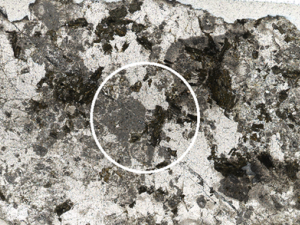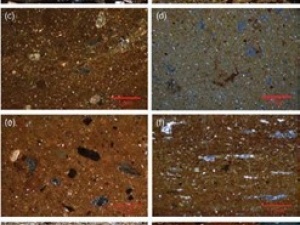Portable XRF and XRD for Geoscience: An Introduction
Geology, also known as geoscience, is the scientific study of the Earth—more precisely, the study of the materials, structures, evolution, and dynamics of the Earth, including its organisms, natural minerals, and energy resources. Geology mainly focuses on the processes that have shaped our Earth and how these processes have changed over time by reconstructing this geological history from rock records. For this purpose, geoscientists routinely investigate the composition and molecular structure of rocks, sediments, minerals, and other geological samples. Geoscientists employ many analytical techniques to characterize these materials and samples—among them X-ray analytical techniques such as X-ray fluorescence (XRF) and X-ray diffractometry (XRD) [1,2].
XRF is the most frequently used analysis technique for determining the elemental composition of rock, sediment, and other earth material samples [3]. In XRF, the sample is bombarded with a high-energy X-ray beam, leading to the ionization of its component atoms and the dislodgment of an inner-shell electron. The resulting electron-hole in the inner shell is then filled by an outer-shell electron accompanied by the release of energy in the form of a photon. The emitted radiation has a lower energy than the absorbed radiation and is termed ‘fluorescence’. The energy of the emitted radiation reflects the energy difference between the two shells involved. As these transitions occur at discrete energies unique to a specific element and its local environment, the emitted characteristic fluorescence can be used to determine the elements in a sample and after calibration, its concentration. Thus, XRF analysis can determine the elemental/chemical composition of a sample but fails to differentiate between the different compounds present in the sample.
Like XRF, XRD measures the response of X-rays interacting with a sample to identify substances. XRD leverages the fact that crystalline materials (e.g., minerals) exhibit a certain degree of periodicity in their structural arrangement [4]. When a monochromatic X-ray beam irradiates a crystalline sample, the X-rays collide with the sample’s electrons, leading to constructive interference (i.e., diffraction) as long as the Bragg’s Law (nλ = 2d sinθ) is satisfied. The law relates the wavelength of the incident beam to the diffraction angle and the distance between the lattice planes of the atoms arranged in the crystalline sample. Each material produces a unique diffraction pattern by which it can be identified. Such diffraction patterns can be compared and matched with those of known structures (e.g., various minerals) maintained in the International Center for Diffraction Data (ICDD) database. In contrast to XRF, XRD identifies and quantifies crystalline compounds or phases in a sample and determines its degree of crystallinity and amorphous content. Thus, the methods are complementary to each other. For example, XRF could measure the total concentration of a specific element (e.g., Ca) in a given geological sample, while XRD could determine and differentiate between the compounds in which this element exists (e.g., CaO vs. CaCO3).
Both techniques have been widely applied in different fields of geoscience for decades, with portable versions of XRF and XRD (pXRF and pXRD, respectively) allowing for fast in situ screenings and analyses [5].
This introduction will briefly describe the advances in pXRF and pXRD, the implication of both methods for geoscience, and their application in soil and rock analysis. The following digest articles will focus on the application of pXRF in geological settings.
Advances in pXRF and pXRD and Their Implications For Geoscience
With advancements in hardware and software technologies (i.e., X-ray tubes, detectors, and processors), pXRF and pXRD devices have become important qualitative and quantitative characterization tools for analyzing geological materials.
Early pXRF spectrometers usually comprised radioactive isotopes as their excitation source and Si-PIN diode detectors, but in later generations, the radioactive isotope sources and PIN diode detectors were replaced by small X-ray tubes and silicon drift detectors, respectively [3,7]. Several generations of improvement have led to the current standard for pXRF, featuring relatively low detection limits, high sensitivity, low background noise, high temperature stability, high resolution at high count rates, and fast processing times. Portable XRF devices have many advantages over traditional lab-based techniques, including, of course, portability, allowing for in situ data collection; little to no sample preparation, facilitating the scanning process; wide dynamic range and multi-element capability, enabling accurate and precise quantification of many elements; and speed, allowing for fast decision-making on site. Moreover, pXRF is a non-destructive technique, allowing for multiple measurements of the same sample and the use of analyzed samples for future use. Using a pXRF device, geoscientists can quickly cover large study areas, increasing the sampling density and advancing decision-making. Modern pXRF devices have integrated GPS receivers that are used to georeference the collected data, enabling rapid spatial visualization using a geographic information system (https://www.olympus-ims.com/en/handheld-xrf-for-soil-surveys-geochemistry-of-rock-outcrops-soils-and-sediments).
Due to these beneficial properties, pXRF devices are widely used in geoscience. Besides the scientific and experimental benefits, pXRF is a highly cost-effective technique; according to an ASX-listed explorer, a saving of $2.75 million over a three-year period was achieved by employing pXRF devices for testing 100,000 samples instead of costly lab-based techniques (https://www.olympus-ims.com/en/handheld-xrf-for-soil-surveys-geochemistry-of-rock-outcrops-soils-and-sediments/). Likewise, the First Mining Finance Corporation used pXRF devices for assessing soil geochemistry within their Sonora projects (Mexico); the estimated costs were approximately 3–5 times less than those of traditional wet chemistry analysis at commercial labs (https://www.olympus-ims.com/en/customer-case-study-soil-geochemistry-by-pxrf-at-the-sonora-project-mexico/).
The digest article “Portable X-ray fluorescence spectrometry analysis of soils” reviews further advantages and disadvantages of pXRF and provides helpful, practical tips and recommendations for its application in the geoscientific field. The remaining digest articles in this eBook demonstrate the high quality of pXRF data obtained from geological samples, which are comparable to those of traditional analytical techniques.
Like pXRF, pXRD has benefited from technological advances, especially from the automation of data processing and the use of vibrating sample holders and CCD-based cameras. Portable XRD devices now offer fast, accurate, and cost-effective analysis of geological samples [5]. Although pXRD devices are larger and heavier than handheld pXRF devices, they can be operated in the field. The ability to identify minerals in situ by pXRD promotes more accurate geological logging and provides valuable insights into geological systems. In contrast to pXRF, pXRD is generally limited to crystalline materials and is thus primarily used for the characterization and identification of crystalline materials in soils and sediments. Nonetheless, it is a commonly used and proven technique to identify and quantify the mineralogical composition of raw materials [8]. However, geoscientists have concluded that pXRD data alone is insufficient for soil mineral identification and thus should be combined with other techniques [9].
Application of pXRF and pXRD in Rock and Soil Analysis
Given the importance of the elemental composition of soils and rocks, the application of pXRF is rapidly expanding in soil and rock analysis. The obtained elemental data can be used to predict soil and rock physical and chemical properties, such as salinity, pH, and cation-exchange capability [3]. Gazley et al. [10] presented a rapid and robust pXRF-based workflow to aid exploration in a regolith-dominated terrane. The authors obtained a large dataset from the Western Mount Isa Inlier, Queensland, Australia, including data from soil, rock, and rotary air blast samples. Portable XRF data obtained from the soil samples were comparable to laboratory data for most elements (Cu and Zn within 2% of laboratory data; Mn, Rb, and Sr within 8% of laboratory data; and Fe, Al, K, and Ca within 25% of laboratory data). However, the Pb content in the soil estimated by pXRF was 77% less than that estimated by the laboratory. This underestimation was due to an erroneous Pb concentration reported by the pXRF device because of overlapping Fe and Pb Kα peaks. The rotary air blast dataset showed a similar trend to the soil dataset (Pb overestimated by 69%), and the rock dataset, which was uncorrected, correlated unexpectedly well with the laboratory data for many elements. Thus, the authors concluded that the use of pXRF enables dynamic exploration campaigns in regolith-dominated terranes at a relatively low cost, with decision-making being possible while the drill rig is still in the study area.
Ahmed et al. [11] used pXRF to evaluate the ore-forming potential of intrusive rocks in different porphyry Cu environments by assessing their Sr/Y and Sr/MnO contents, which are effective discriminators between ore-forming and unprospective intrusions. For this purpose, pXRF data were collected from pulp powders and rock slabs from six porphyry Cu districts. Calibrated pXRF data obtained from pulp powders correlated very well with those of conventional methods (within 16%). In contrast, pXRF data obtained from rock slabs correlated less well with those of conventional methods (within 37%). This discrepancy in the data between the samples was due to homogeneity differences (in terms of grain size and mineralogy) between pulp powder and rock slabs. Nevertheless, pXRF represents a rapid and cost-effective alternative to traditional methods for collecting Sr, Mn, and Y data to determine the ore-forming potential of intrusions.
Portable XRF can also be applied in geological oceanography to study the geological history of the ocean floor. Ivanova et al. [12] used pXRF, in combination with other techniques, to analyze the sediment cores from the summit and the northeastern slope of the Ioffe Drift, which is located in the Antarctic Bottom Water pathway. The study was conducted to identify hiatuses in the contourite records, determine their duration, and refine the stratigraphy of the upper sediment cover overlaying the Ioffe Drift area. The Ca/Ti and Ca/Al ratios were determined by pXRF as they represent biogenic/terrigenous material ratios, reflecting the changes in terrigenous sediment contribution. Abrupt changes in the XRF data were used to infer potential long- and short-term hiatus/erosional events over the last ~ 3 million years. The authors demonstrated that continuous pXRF scanning, in combination with other techniques, is an excellent approach to identifying hiatuses, even short-lived ones.
Portable XRD is particularly useful for on-site mineralogical analysis and geological exploration. For example, in the Indika project, pXRD was used for testing critical mineral identification in two study areas in northern Finland [13]. Using pXRD, the authors successfully detected common rock-forming minerals, such as albite, amphiboles, muscovite, and quartz, and indicator minerals for both study areas in till and weathered bedrock samples. However, as mentioned before, the authors also noted that the pXRD data alone was not reliable enough without employing complementary methods. Another study demonstrated that pXRD could be applied to identify hydrothermally modified mineral fissures, which can be used to track the formation conditions for ore deposits and other geothermal systems [14].
Besides being largely used individually, pXRF and pXRD were also combined to investigate a large set of complex geological samples [15]. Coupled pXRF-pXRD analysis delivered both elemental (XRF) and mineralogical (XRD) information of high quality, making it a promising method for the exploration of lithologies, hydrothermal alterations, and ores.
References:
[1] T. D. T. Oyedotun, Geol Ecol. Landsc. 2018, 2, 148.
[2] B. Lavina, P. Dera, R. T. Downs, Rev. Mineral. Geochem. 2014, 78, 1.
[3] D. C. Weindorf, N. Bakr, Y. Zhu, Adv. Agron. 2014, 128, 1.
[4] D. M. Moore, R. C. Reynolds Jr., in X-Ray diffraction and the identification and analysis of clay minerals, Oxford University Press, New York, 1997.
[5] B. Lamiere, Y. A. Uvarova, Geochem. Explor. Env. A. 2020, 20, 205.
[6] D. J. Kalnicky, R. Singhvi, J. Hazard. Mat. 2001, 83, 93.
[7] D. C. Weindorf, S. Chakraborty, Soil Sci. Soc. Am. J. 2020, 84, 1384.
[8] P. S. Nayak, B. K. Singh, Bull. Mater. Sci. 2007, 30, 235.
[9] V. Singh, H. M. Agrawal, Radiat. Phys. Chem. 2012, 81, 1796.
[10] M. F. Gazley, L. C. Bonnett, L. A. Fisher, W. Salama, J. H. Price, Aus. J. Earth Sci. 2017, 64, 903.
[11] A. Ahmed, A. J. Crawford, C. Leslie, J. Phillips, T. Wells, A. Garay, S. B. Hood, D. R. Cooke, Geochem. Explor. Env. A. 2020, 20, 81.
[12] E. Ivanova, D. Borisov, O. Dmitrenko, I. Murdmaa, Mar. Pet. Geol. 2020, 111, 624.
[13] P. Sarala, H. Koskinen, Geologi 2018, 70, 58.
[14] D. A, Burkett, I. T. Graham, C. R. Ward, Canad. Mineral. 2015, 53, 429.
[15] Y. A. Uvarova, J. S. Cleverly, A. Baensch, M. Verrall, Coupled XRF and XRD analyses for efficient and rapid characterization of geological materials: Applications for the mineral exploration and mining industry, conference paper at the 21st General Meeting of the International Mineralogical Association (IMA), Johannesburg, 2014.
Source: Preview Image: Aarre Rinne/Getty Images






